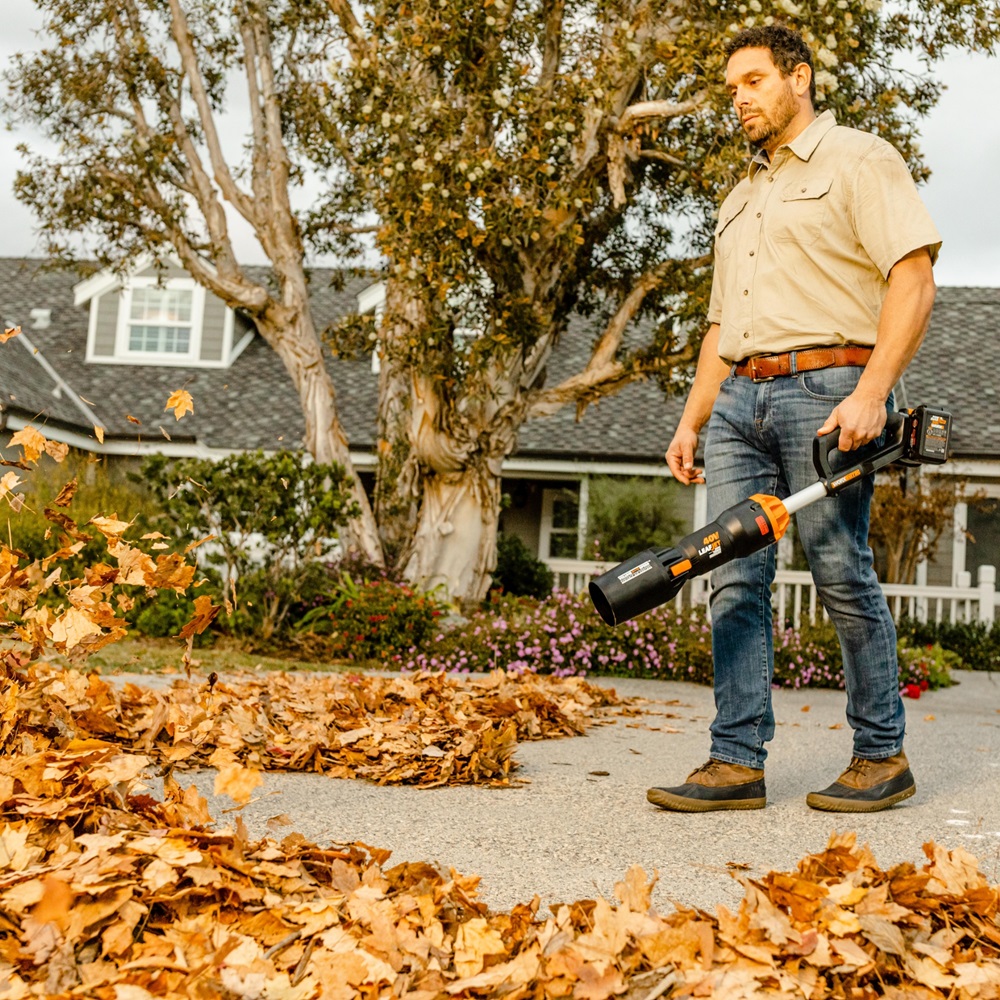Are you on the hunt for the perfect leaf blower but feel lost in a sea of technical jargon? You’re not alone.
Understanding the difference between CFM (Cubic Feet per Minute) and MPH (Miles Per Hour) can be confusing, yet it’s crucial for making the right choice. Imagine the satisfaction of effortlessly clearing your yard, knowing you picked the right tool for the job.
We’ll break down these terms in simple language and help you decide which matters more for your needs. By the end, you’ll not only know the difference but also feel confident in choosing a leaf blower that fits your lifestyle. Ready to simplify your decision-making process and find your perfect match? Let’s dive in!
Leaf Blower Basics
Understanding leaf blower performance involves comparing CFM and MPH. CFM measures air volume, while MPH indicates air speed. Choose a blower with a balance for efficient leaf clearing.
Leaf Blower Basics Fall brings a cascade of vibrant leaves, creating a picturesque scene. However, when those leaves start cluttering your yard, a leaf blower becomes your best friend. Choosing the right leaf blower involves understanding two key terms: CFM and MPH. These metrics play a crucial role in how effective your leaf blower will be.What Is Cfm?
CFM stands for Cubic Feet per Minute. It measures the volume of air a leaf blower can push out in a minute. Think of it as the width of air expelled. A higher CFM means the blower can move more leaves at once. It’s particularly useful when dealing with large piles of leaves or damp debris. Imagine trying to move a big pile of leaves with a straw versus a wide tube. The wider tube (higher CFM) does the job faster and more efficiently. If you have a large yard, you might want to prioritize a blower with high CFM.Understanding Mph
MPH stands for Miles per Hour. It measures the speed at which air exits the leaf blower. This is the force behind the air, similar to wind speed. High MPH is ideal for moving stubborn, stuck-on leaves and debris. It can help dislodge leaves wedged in tight spaces, like between rocks or in gutters. Picture trying to blow a leaf across a patio with a gentle breeze versus a strong gust. The gust (higher MPH) will push the leaf farther. If precision and power are what you need, then focusing on a blower with high MPH might be more effective for you. Balancing CFM and MPH is key. Some leaf blowers boast high MPH but low CFM, or vice versa. Consider your yard’s needs: is it more about moving large quantities or tackling tough spots? Are you ready to tackle your leaf problem efficiently? Understanding these basics can guide you to the perfect choice, making yard work less of a chore and more of an accomplishment.Importance Of Cfm
When choosing a leaf blower, understanding CFM is crucial. CFM, or cubic feet per minute, measures the volume of air the blower can move. It influences how effectively you can clear debris from your yard.
I once spent an entire afternoon chasing stubborn leaves with a low CFM blower. They danced back and forth, refusing to budge. That’s when I realized that CFM plays a key role in performance. Let’s dive deeper into why this matters.
Volume Of Airflow
CFM indicates how much air flows through the blower at any given time. Think of it as the blower’s power to push leaves away. A higher CFM means more air is moving, which helps clear larger areas faster.
Imagine standing on your porch and effortlessly sweeping leaves off your driveway with a high CFM blower. Wouldn’t that be a game-changer for your yard work routine? Consider this next time you’re shopping.
Impact On Performance
Performance isn’t just about speed; it’s also about efficiency. While MPH measures air speed, CFM determines how efficiently the blower can move leaves and debris. High CFM ensures leaves don’t simply scatter but are pushed away effectively.
Have you ever spent time gathering leaves only to find them scattered again? That’s where a good CFM comes in handy. It helps you work smarter, not harder, saving you time and energy.
Choosing the right CFM is about balancing speed and efficiency. What matters most to you: speed or thoroughness? This decision could transform your leaf-blowing experience.
Significance Of Mph
The term MPH, or miles per hour, is crucial for understanding leaf blowers. MPH measures the speed of the air coming out of the blower. A higher MPH means the air is moving faster. This speed affects how well the blower can move debris. It’s vital for those needing to clear large areas quickly.
Speed Of Airflow
The speed of airflow determines how effective a leaf blower is. A higher MPH means more power to lift leaves and debris. This is essential for stubborn, wet leaves. Faster airflow can handle tougher cleanup jobs. It ensures leaves are moved far from the original spot. For big yards, this speed is very important.
Role In Debris Movement
MPH plays a key role in moving different types of debris. Faster air can push not just leaves but small sticks or dirt. This makes yard cleaning more efficient. It reduces the time spent on manual collection. For heavy or damp debris, higher MPH is better. This means less effort for the user.

Credit: m.youtube.com
Cfm Vs Mph: Key Differences
When choosing a leaf blower, understanding the difference between CFM and MPH can make a huge difference in your yard work efficiency. These two metrics often confuse users, but they serve distinct purposes. Knowing how each impacts the performance of your leaf blower can help you make the best choice for your gardening needs.
Volume Vs Speed
CFM, or Cubic Feet per Minute, measures the volume of air a leaf blower can expel. Imagine a wide river flowing steadily; it represents the amount of air moving through the blower. A higher CFM means your blower can move more leaves at once, making it ideal for larger areas.
On the other hand, MPH, or Miles per Hour, focuses on speed. It’s like a fast-moving stream cutting through a narrow channel. High MPH is perfect for stubborn debris or wet leaves. It’s about precision and power to tackle specific tasks.
Applications And Use Cases
Consider where you plan to use your leaf blower. If your yard is filled with thick layers of leaves, a blower with a high CFM will clear them faster. You’ll spend less time wrestling with piles and more time enjoying your tidy yard.
But what if you need to clear leaves from a tight corner or under bushes? That’s where high MPH shines. It blasts away debris with force, reaching areas a high CFM might struggle with. Remember, it’s not just about power but how you use it.
Think about your yard’s unique challenges. Do you need to move a large volume of leaves quickly, or is precision more important? The choice between CFM and MPH can change your yard work experience dramatically.
Can you imagine how much easier your life would be with the right tool? Consider your needs carefully, and you’ll transform your yard with ease. Whether it’s volume or speed, understanding these metrics can help you choose the perfect leaf blower for your tasks.
Choosing The Right Leaf Blower
Choosing the right leaf blower can be a challenging task. Understanding the balance between CFM (Cubic Feet per Minute) and MPH (Miles per Hour) helps in making a good decision. This guide will help you pick the perfect leaf blower for your needs.
Assessing Your Needs
Consider the size of your yard. A small yard may not need a powerful blower. For larger areas, a higher CFM might be necessary. Think about the type of debris you need to clear. Wet leaves require more power. Dry leaves can be moved with less effort. Decide how often you will use the blower. Frequent use may require a more durable model.
Balancing Cfm And Mph
Both CFM and MPH are important in a leaf blower. CFM measures the volume of air a blower moves. MPH measures the speed of the air coming out. A high CFM moves more leaves at once. A high MPH moves leaves faster. For heavy, wet leaves, focus on CFM. For light, dry leaves, a high MPH might be better. Find a balance that suits your yard’s needs.

Credit: www.worx.com
Impact On Efficiency
When choosing a leaf blower, understanding the difference between CFM (cubic feet per minute) and MPH (miles per hour) is crucial for efficiency. Both metrics impact how well a leaf blower performs in various situations. CFM measures the volume of air moved, while MPH gauges the speed of air. Which is more important? It depends on the task at hand and the environment you’re working in.
Efficiency In Different Scenarios
Imagine you’re clearing leaves from a wide-open lawn. Here, a high CFM rating is your best friend. It ensures a larger volume of air moves, covering more ground quickly. Conversely, if you’re dealing with wet, stubborn leaves in tight spaces, MPH becomes vital. The higher air speed can dislodge sticky debris effectively.
Think about your typical yard tasks. Do you often tackle large piles of dry leaves or fight against damp, heavy debris? Answering this helps determine the right balance between CFM and MPH for your needs.
Practical Examples
Consider a leaf blower with a CFM of 450 and MPH of 150. This combination is excellent for routine yard maintenance where leaves aren’t too challenging. You can efficiently clear paths and garden beds without much hassle.
On a windy day, you might face a different challenge. A blower with 250 CFM but a hefty 200 MPH can counter gusts, ensuring leaves don’t scatter unpredictably. It’s about matching your blower’s capabilities to the day’s conditions.
Have you ever had to clear gravel or mulch from your driveway? A high MPH rating helps target specific areas without disturbing heavier materials. It’s these practical examples that reveal how CFM and MPH can work together or separately to make your tasks easier.
Next time you’re choosing a leaf blower, think about these scenarios. What tasks do you tackle most often? How does your yard’s layout affect your choice? These questions can guide you to the perfect balance of CFM and MPH, maximizing your efficiency and making yard work less of a chore.
Technological Advancements
Understanding leaf blower power involves comparing CFM (Cubic Feet per Minute) and MPH (Miles per Hour). CFM measures air volume, while MPH gauges air speed. Both are crucial for evaluating a leaf blower’s efficiency.
When considering the efficiency of leaf blowers, CFM (cubic feet per minute) and MPH (miles per hour) are crucial metrics. With technological advancements, these machines are becoming more effective and user-friendly. These innovations are changing the way we maintain our gardens and outdoor spaces.Innovations In Design
Design innovations are enhancing leaf blower performance significantly. New models are incorporating lightweight materials, making them easier to handle for extended periods. A few years ago, I struggled with a bulky blower that left my arms sore. Now, the sleek and ergonomic designs make yard work a breeze. Manufacturers are also focusing on noise reduction technologies. This is a game-changer for neighborhoods where noise can be a significant issue. Imagine cleaning your yard without disturbing your neighbors or needing ear protection. Battery technology is another area of improvement. Today’s battery-powered blowers offer longer run times and faster charging. This means less downtime and more time getting your work done efficiently.Future Trends
The future of leaf blowers looks promising with smart technology integration. Imagine a blower that adjusts its power based on the density of leaves. Such advancements could save energy and increase the lifespan of your tool. There is also an increasing trend towards eco-friendly options. Electric and battery-powered blowers are becoming more popular due to environmental concerns. These options reduce emissions and are quieter, offering a double benefit. Consider the potential for AI-powered systems in leaf blowers. Could they predict the optimal time for yard work based on weather patterns? The possibilities are exciting and can transform our approach to outdoor maintenance. Are you ready to embrace these advancements in your gardening routine? What features would make your leaf blower experience more efficient and enjoyable?Expert Tips For Buyers
Choosing the right leaf blower can be daunting. Buyers often get confused between CFM and MPH. These are key factors in a leaf blower’s performance. Understanding these can help you make an informed decision.
Key Features To Consider
CFM stands for Cubic Feet per Minute. It measures the volume of air the blower can expel. A higher CFM means the blower can move more leaves. MPH, or Miles Per Hour, measures the speed of the air. A higher MPH means the air moves faster. Consider both CFM and MPH together. This gives a clear picture of the blower’s power.
Check the weight of the leaf blower. Lighter models are easier to handle. Noise level is another important factor. Look for a model with a lower decibel rating. This is especially important in residential areas.
Maintenance And Care
Regular maintenance keeps your leaf blower in top shape. Clean the air filter frequently. This ensures efficient performance and longevity. Check the spark plug if you have a gas model. Replace it if worn out. Inspect the fuel system for leaks. Regularly tighten any loose screws or bolts.
Store the leaf blower in a dry place. Protect it from harsh weather conditions. Drain the fuel before long-term storage. This prevents the fuel system from clogging. Regular maintenance saves money and increases the blower’s lifespan.

Credit: www.protoolreviews.com
Frequently Asked Questions
What Does Cfm Mean In Leaf Blowers?
CFM stands for Cubic Feet per Minute. It measures airflow volume. Higher CFM means more air moves through the blower.
Why Is Mph Important For Leaf Blowers?
MPH stands for Miles per Hour. It measures airspeed. Higher MPH helps blow leaves farther and faster.
Which Is Better: Higher Cfm Or Higher Mph?
Both are important. CFM handles large leaf piles. MPH focuses air on stubborn debris. Balance is key.
How Do I Choose Between Cfm And Mph?
Consider your yard size. Larger yards may need higher CFM. Small areas might benefit from higher MPH.
Can Cfm And Mph Affect Leaf Blower Efficiency?
Yes. Efficient blowers balance CFM and MPH. This ensures effective leaf removal without wasting energy.
Conclusion
Choosing between CFM and MPH depends on your needs. CFM measures air volume, ideal for big areas. MPH gauges air speed, perfect for stuck debris. Consider task type and blower power. Both metrics matter for efficiency. Think about your yard size and debris type.
A balance of CFM and MPH is crucial. Higher CFM suits leaves, higher MPH tackles stubborn dirt. Select a blower that matches your requirements. Understand your yard’s demands. Make an informed choice for better results. This will ensure effective and enjoyable yard maintenance.
Your yard will thank you!




